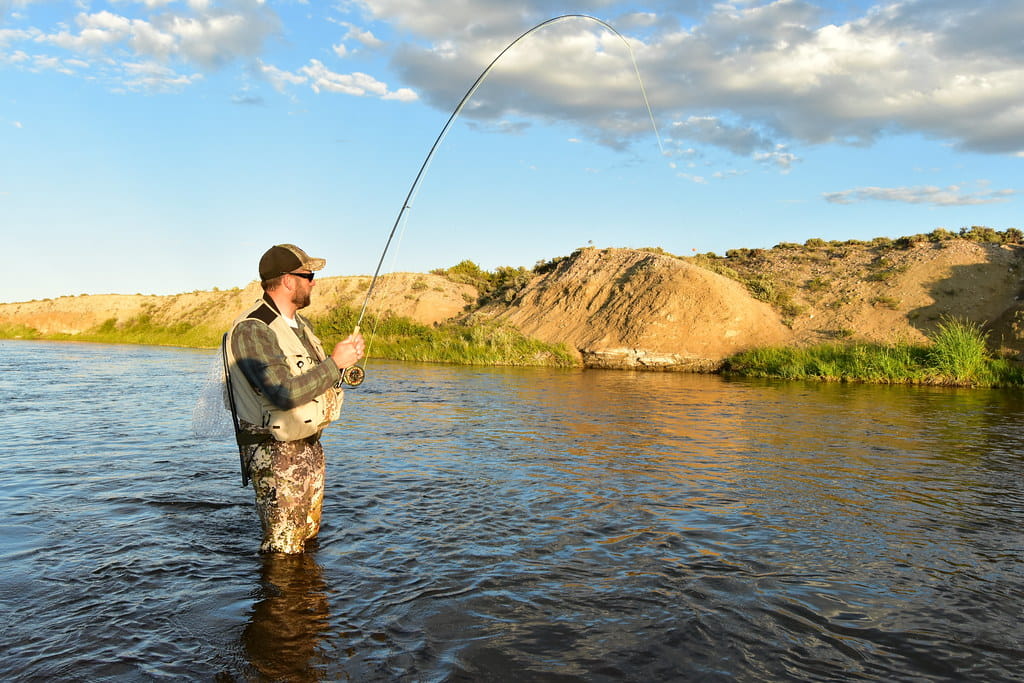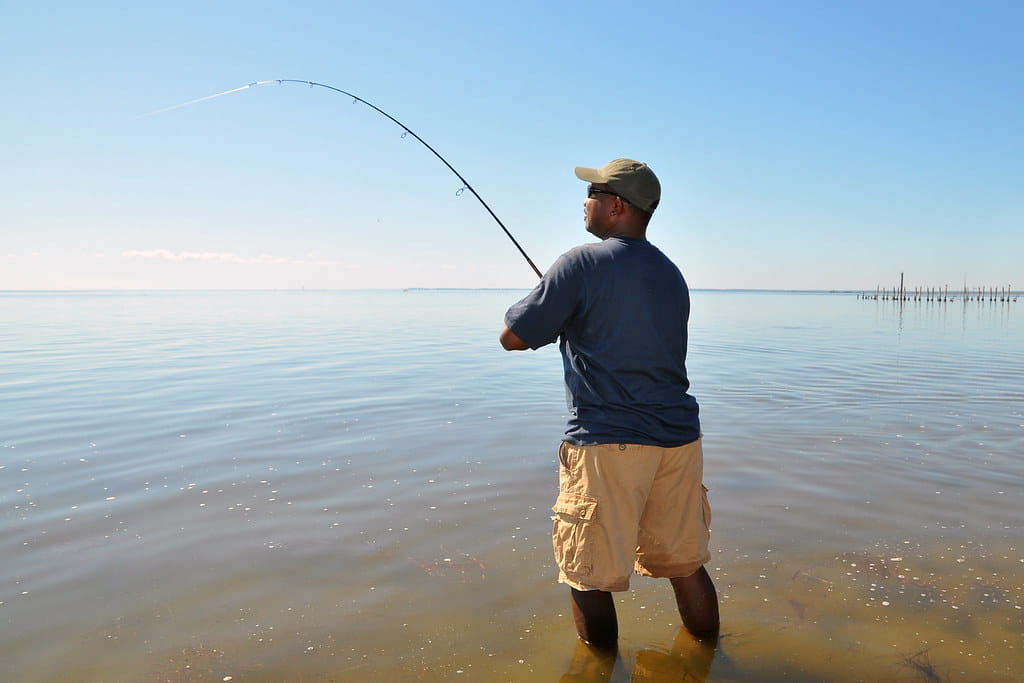Fly fishing with a bubble float can bring a successful angling trip with exciting moments. Yet, you only have such experience if you know how to do it correctly.
This fishing approach requires a set of gear and some techniques. As long as you check our guide before heading to the fishing spot, you won’t make mistakes.
Now, let’s join us and be ready for a fantastic journey!

The Right Equipment For Fly Fishing With A Bubble Float
Fly fishing with a bubble float is one of the most effective ways to catch coastal sea fish. In most cases, a bubble float angler can “outfish” a spin and fly fisher.
The technique can also work for many other types of fishing, including dry fly angling in streams with a bobber.
It may be easier to manage than fly fishing with a fly line as there is less drag.
Before any fishing trip, careful preparation is the most important step. So what gear should you pack to maximize your performance?
This section will reveal the answer.
Rod
Since spinning gear is most suitable for the light lines when you are bubble fishing, most anglers employ the method while casting an ultra-light rod.
When fishing waterways whose sides have thick brush and weeds, some anglers choose rods that are no longer than 5 feet.
If the lakes and rivers are wider, go for the 6- to 8-foot rod. Besides, the rod’s tip needs to have a swift action.
Shorter poles are easier to pack and transport while fishing in remote locations, while longer ones can cast farther and more mimic the motion of a fly rod.
Reel
The ideal reel for bubble float fishing is a spinning reel. Your reel should feature a smooth-operating bail and can retrieve action.
If possible, choose the high-quality drag too so you can control the light lines effectively.
Line
This fishing technique requires a line that is 4 to 6 pounds heavy.
Anglers often prefer the lighter ones with a leader to attach the fly. In this case, they choose the 2- to 4-pound line.
When setting up your pole, ensure the line can pass all guides. Even if you only miss one, everything will become a mess, and you won’t cast successfully.
How about the leader length? Your decision on the leader length depends on your chosen type of fly.
For example, the dry flies should be 9 feet, while the wet ones are often 6 feet. Yet, some anglers choose 5- to 7-foot leaders and don’t mind the type of fly.
Besides, depending on the weather, the condition of the waters, and your preferences, you might want to try out different lengths.
To prevent the plastic bubble from dropping down to the fly, you need to hook the leader to a little pivot once you’ve tied the bubble onto the line.
Although some anglers like using the same type of tapered leader, others enjoy using conventional monofilament.
Bubble
The bubble fly rig allows you to cast fishing flies without a rod using a transparent plastic float.
You can also use it to cast light baits and lures that are challenging to throw with traditional fishing equipment like spinning or bait-casting rods.
- Shape
In bubble fishing, a teardrop-shaped plastic bubble is most frequently used, with the thin end toward the lure and the thick end towards the rod.
Though some want spherical bubbles, others prefer a more tapered one that is widest in the middle and equally thin on either tip.
- Weight
The float offers the required weight to throw them with conventional equipment because it is heavier and thicker than the fishing bait, lure, and fly.
If you need the bubble to be heavier, you can add some vegetable oil or water inside to fill the float’s empty body.
- Material
The transparent material is similar to spooking fish. The fish see these floats as bubbles floating in the water, giving it the name of “bubble fly fishing.”
Flies
Choosing the right flies for your fishing is essential. Although most flies can help with your bubble fishing, the modest selection is what you really need.
Bass and panfish are much less picky about the fly they’ll strike. Yet, trout fishing often needs you to “match the hatch” with the specific fly the trout feed on.
Here is a list of potential flies:
- Dry flies: Black Gnat, Adams Irresistible, El Capitan, Red Ant, Gray Wulff, Ginger Quill, California Mosquito, and Royal Coachman.
- Wet flies: Muddler Minnow, Wooly Worm, and Wooly Bugger.
How To Fly Fish With A Bubble Float?

Now everything is ready to work. After gathering all your necessary gear, let’s follow these steps to catch fish with the lovely bubbles.
Step 1: Cast sidearm
Casting sidearms can allow the bubble to follow the fly while casting (much like heavy lines follow the leader when fly casting.
The sidearms also enable the fly to land gently, keeping the leader from splitting on above branches or in any other way.
Step 2: Count the fly
Before starting your retrieve, allow the submerged flies to sink 5 to 10 feet deep.
If you put a bubble and a fly into the water and measure how long they need to sink to a certain depth, you can determine the rate of fall.
You can start counting to this depth when you throw the fly before retrieving it.
Step 3: Retrieve the flies slowly
When fishing closer to the surface, try to perform your fly as it’s drifting toward shore with the current and can twitch to simulate struggling.
To mimic a swimming crustacean or minnow, fish the submerged flies slowly or with a stop-and-go pattern.
You can use the bubble to tell the difference between when a trout strikes the fly and when it meets something else.
Your bubble should generate just enough of a wave in calm water to give enough resistance to the fishing line.
Step 4: Observe the bubble
Waiting is a part of fishing. During this waiting time, keep your eyes on the bubble. If it suddenly bobs or dips, a fish may take the fly.
Step 5: Set the hook
Setting the hook in a quick, accurate action will aid in anchoring it. Revert to your prior slow retrieve approach if you can’t set the hook.
The fish will think that it just hurt the fly and then start attacking for the kill.
Extra Tips For Fly Fishing With A Bubble Float
Aside from the gear and steps we have shared, you also need to pay attention to other things, such as:
- Bubble floats are the best choices for anglers who wish to use fishing flies but don’t have a fly fishing reel or rod, have one but want to learn how to fly fish, or prefer a backup rod when the fly rod fails.
- The bubble can be heavy or lightweight because it has an empty body, but you can add oil or water inside.
- Using the same flies, you can use the bubble rigs in the same ponds, lakes, and rivers to catch fish aimed by the fly angler.
- The bubbles are flexible, so you can use them for wet flies, dry flies, streamers, and nymphs. They also do an excellent job fishing lightweight lures like Trout Magnets or Power Worms.
- Remember to bring a fly fishing vest and a tackle box because you will need them.
- Some anglers use the bubbles on a motionless drift, twitch them with short pulls, or a steady retrieve. Feel free to choose your favorite approach if the fish will bite.
Conclusion
Fly fishing with a bubble float will be a breeze once you know what to do with it. Try to prepare the essential tools and use the technique for the best result.
Hopefully, your fishing isn’t a hassle anymore. Whenever you want to fish, re-check our guide, and you won’t miss anything. Thanks for reading!